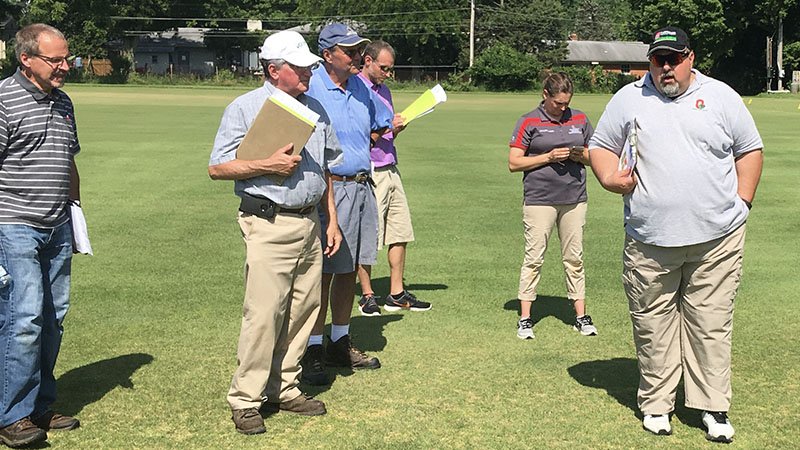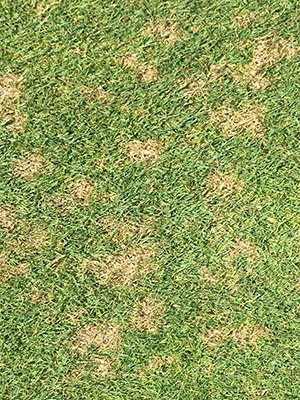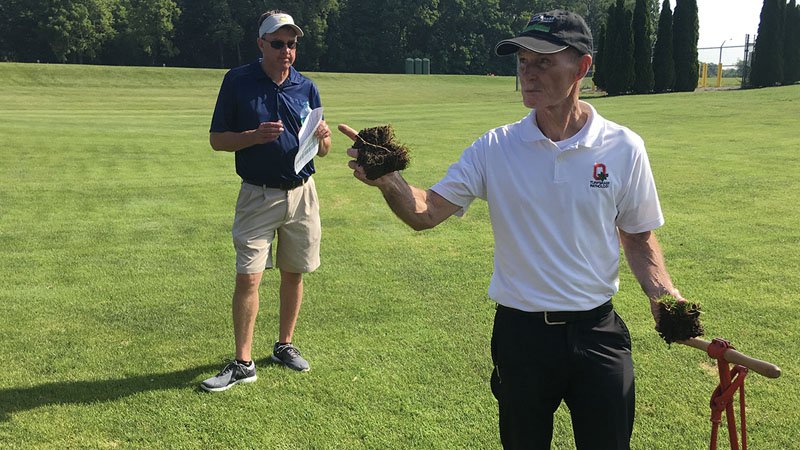
When tallying infection centers in dollar spot trial plots, Todd Hicks and Joe Rimelspach rarely count all of them.
Hicks, program coordinator for Ohio State University's turfgrass pathology department, had some advice for about 30 attendees at this year's Disease Day workshop in Columbus.
 "Once you get past 25, who cares? The fungicide doesn't work," Hicks said.
"Once you get past 25, who cares? The fungicide doesn't work," Hicks said.
Disease Day is a half-day workshop at the at the Ohio Turfgrass Foundation Research Center that helps superintendents, athletic field managers, lawn care operators and sod growers identify common diseases in turfgrass and the best options to manage them.
"A lot of the things we do in the turf industry we know are not promoting maximum health, i.e., the mowing height of the turf we are standing on right here," Rimelspach, program specialist in OSU's turf pathology department, said while standing on a brown patch test plot maintained at fairway height.
"It is a two-step process to manage disease: stop the fungus and grow the host. These leaves, even with holy water, are not going to be normal again. They're going to die. The goal is not to let new leaf tissue get infected."
The workshop included information on diseases like brown patch, red thread, rust and more, much of the focus was on dollar spot, which has been making show-stopping appearances across Ohio in recent years.
Historically, dollar spot makes a brief appearance in spring, goes away then returns in mid- to late June or early July. That has not been the case recently.
"The last two years, it comes early, stays and doesn't fade away," Hicks said. "Then it seems to go to sleep for a little bit, then comes right back where it left off."
That can be a problem for superintendents, sports field managers and lately even lawn care operators. Hicks and Rimelspach provided an update on some ongoing trials, including some experimental products. Download their fungicide chart for more information on specific fungicides.
"That's kind of what we're dealing with right now, dollar spot in fairways," said Dan Smith, second assistant at Double Eagle Golf Club in nearby Galena. "This was valuable information that we learned her today."
For a disease that first was diagnosed nearly 100 years, dollar spot still is a problem with a lot of unknowns.

Dollar spot in turfgrass was identified in 1937 as being caused by the pathogen Sclerotinia homeocarpa. Ever since, scientists have been trying to learn even more about the disease and what causes it. Research conducted by scientists at Ohio State, Rutgers and North Carolina State and the U.S. Department of Agriculture has identified a new genus and four species - not just one - that cause dollar spot in turfgrass.
The new genus, Clarireedia, is named for former Rutgers turf breeder C. Reed Funk, Ph.D. Among the four species identified, two occur primarily in North America and two in Europe, according to the research.
Once you get past 25, who cares? The fungicide doesn't work.
Like so many problems facing turfgrass managers, the dollar spot pathogen can lie undetected, awaiting waiting for just the right time to appear, which makes application timing critical to success.
"The key with dollar spot is to go out with early season control and get the inoculum level knocked down," Hicks said. "Remember, dollar spot goes through a whole series of events before you see it. It's right there before you can see it, just waiting. Then you go out with your application and three days later you have spot and you're making a call saying, 'hey, the crap you sold me doesn't work.' You have to look at the weather patterns, and you probably were late, you just didn't see the damage yet. It's like having cancer and not knowing it until someone tells you at the doctor's office that you're dying."
So, what is the magic number of acceptable infection centers on those test plots?
"It's probably one," Hicks said. "These are 3-foot-by-5-foot plots, and if every plot across a green had just one, that would be unacceptable for you."

